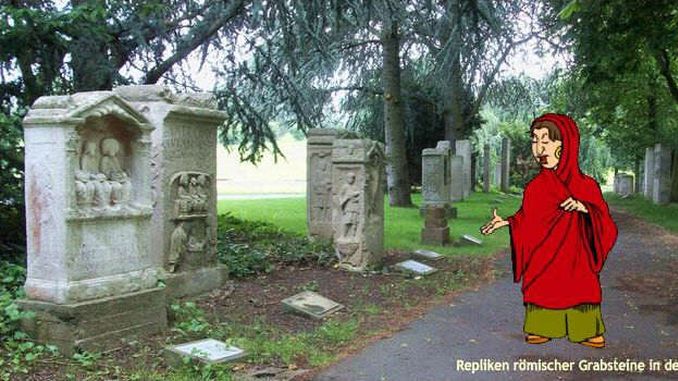
Late Antiquity. Emperor Constantine had the Rhine border reinforced. About a century later, thousands of barbarians crossed the frozen Rhine.
At the end of the third century, a strong ruler ascended to the throne: Diocletian (284-305). To better rule the enormous empire, he split in into an eastern and a western half and appointed a co-emperor, and both emperors appointed an army leader as junior emperor (tetrarchy). The western junior emperor ruled in today’s Trier (Augusta Treverorum), so almost at the Rhine border. Diocletian re-arranged the Roman provinces. Germania Inferior remained to a large extent the same, only its name was changed into Germania Secunda. Germania Superior was split up.
Constantine
Yet, the four men rule did not last for long. Already emperor Constantine (306-337) prevailed in a bloody struggle for power against his rival emperor. According to the legend, he owes his victory at the Milvian Bridge to the Christian God. During his reign, in 313, Christianity, still pursued under Diocletian, became a recognized, even privileged religion, although still no state religion. Constantine himself did not live it; like so many other emperors he was a power hungry man who had competitors killed, even in his own family. Constantine founded a new capital, Constantinople at the Bosporus, later Byzantium, today Istanbul.
Fort Deutz
The Rhine border was fortified, and also in the hinterland cavalry units were stationed. In Cologne-Deutz, around 310 the fort Deutz (castellum divitia) came into being. Men from the XXII. Legio Primigenia built it using trachyte from the Drachenfels again. In addition, the first paved Rhine bridge connected the fort with the city. At that time, about 20,000 people lived in the Roman city Colonia Claudia Ara Agrippinensium and its surroundings. Archaeologists have found proves that the region was a cosmopolitan one already back then: besides the Romans and their gods there were a Christian municipality, a Jewish, and also people who believed in Isis and Mithras. Maternus (313/314) was the first bishop in our area that we know by name.
The Franks conquer Bonn and Cologne
When another bloody struggle for power broke out in the Roman Empire after Constantine’s death, the Alamanni and Franks again crossed the Rhine. Around 350, the Alamanni had brought large parts of east Gaul under their control. In 353, the Franks destroyed the garrison in Bonn, in autumn 355, they conquered and plundered Cologne.
Then Constantine’s nephew Julian, commander of the Gallic army, could push them back across the Rhine after violent fights (363). He re-conquered Cologne and had the garrison in Bonn reconstructed and fortified. Shortly after, he became emperor (361-363). His surname “the Apostate” emphasized that he wanted to repel Christianity, yet he never had other religions prosecuted. Julian died on a campaign against the Sassanid Persians; all following emperors were Christians.
Back then, Rome permitted the Franks to settle in Toxandria, today’s Belgium. More and more Franks came, and eventually, they were the largest ethnical group. It was a peaceful transition, and numerous Franks, among them the first Merovingians, served in the Roman army. The Ripuarian Franks on the right bank, however, remained enemies.
Huns
Since 395, the Empire was divided in a West Roman and an East Roman Empire. The Western Empire was in a constant defense fight; there was an increasing number of foreigners in its army and the commanders in chief, the army masters, were predominantly Germanics. In the 5th century they were, in reality, the mightiest men in the West Roman Empire. The biggest danger for Rome loomed in the east: the Huns from Central Asia had migrated to the west, killing and destroying everyone and everything in their way. In 375, they destroyed the realm of the Ostrogoths in the south of the today’s Ukraine. The defeated people had to serve in the Hunnish army. Others fled for their lives and sought protection in the Roman Empire.
Visigoths
Also the Visigoths lived as allies (foederati) on Roman territory. Several times, emperor Theodosius I. fought for the throne of the Western Roman Empire, and always the Visigoth auxiliaries suffered particularly heavy casualties. When they were finally allowed to return, they found their settlements destroyed by the Huns. As they did not find peace in the East Roman Empire, and marched under their leader Alaric through the Balkans into the West Roman Empire. By 401/402, they had reached Italy. Emperor Honorius moved with his court to Ravenna which was considered impregnable. His army master Stilicho, a Vandal, could defeat the Visigoths. But already in 405/406, another army under the Goth Radagaisus invaded Italy, and still Alaric and his troops stood at the border of Italy. In this emergency, the Romans withdrew troops from the Rhine.
The collapse of the Rhine border
In winter 406/407, thousands of Vandals, Suebians and Alans crossed the frozen Rhine close to Mogontiacum/Mainz, overran the Franks loyal to Rome on the left bank and invaded Gaul. For long years, anarchy and great need prevailed in Gaul. Frankish crowds stormed Cologne. In 440, the Romans reconquered the city. In 446, the Franks again invaded. One more time the Romans could repel them, but it became obvious that Roman rule would end.
Aëtius, Attila and the battle on the Catalaunian Plains
Around 450, the King of the Huns, Attila, ruled over a giant empire stretching from the Volga river in the east to the Rhine in the west, he was the mightiest man of the known world. On behalf of Rome, the mighty army master Flavius Aëtius (390-454) had maintained good relations with him. But then it came to a discord, and Attila took up arms. In spring 451, Hunnish troops stood at the Rhine. The Alamanni fought them, the Franks on the right bank submitted and had to serve as auxiliary troops in Attila’s army. While Aëtius summoned his armed forces together, Attila’s army penetrated into the interior of Gaul.
On the Catalaunian Plains, assumed near today’s Châlons-en-Champagne or Troyes, the two armies met one another. On both sides, partly forced coalitions faced one another. Only about half of the soldiers in Attila’s army were Huns, the other half were Ostrogoths, Gepids, Burgundians and the only recently defeated Franks from the right bank of the Rhine. In Aëtius’ army, the Visigoth provided half of the soldiers, the other half were West Romans, Franks from the left bank of the Rhine, Burgundians, and Alans. Aëtius and his allies defeated the Huns, and Attila withdrew from Gaul. Two years later he died, and his Empire fell apart. Aëtius did not outlive him for long, in 454 he was murdered.
The end of the Roman rule in the Rhineland
In 455, the Franks sacked Cologne. The Roman rule in the Rhineland was over, and around 475, also the Latin language had disappeared.
A look beyond the Rhineland
The Romans had conquered Britain in a forty year long bloody war (Roman Britain, 44-407). In 122, emperor Hadrian, who visited almost every Roman province, came to the Rhine. From there he traveled on to Britannia, and took the legion VI Victrix from Neuss and units of the legion I Minervia from Bonn with him. So probably men from Bonn helped building Hadrian’s Wall.

those described are official macro-historical facts
it’s more interesting to know what happened in normal periods of peace
what were the daily interactions between Romans and Germans along the Rhine border
were Franks nearly allied with Rome?
Yes, that’s right, history books don’t write much about the daily life back then, let alone people like you and me. We learn much more from good historical movies and period dramas. Unfortunately, we know little about the time of the Romans and Franks on the Rhine, and we have only Roman sources. From the end of the 3rd century onwards, the Franks were allowed to settle on the left side of the Rhine, they became Roman federates and served in the Roman army. The Franks on the right side of the Rhine remained enemies. If you know German, I have a longer story about a fictional Roman-Ubian family on my German site, Leben an der Rheingrenze (Life on the Rhine border), that is about everyday life back then.
https://roemer.rheindrache.de/
I plan to publish it in English, yet that will take a couple of weeks.
Take care and stay safe! Petra